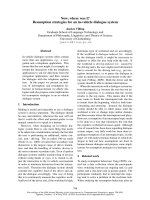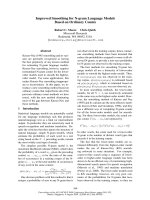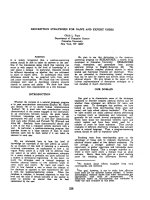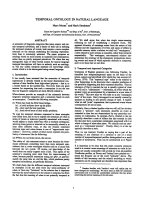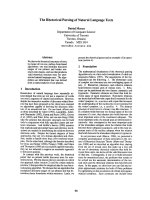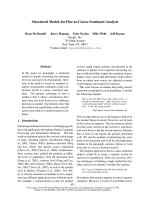Báo cáo khoa học: "Learning Strategies for Open-Domain Natural Language Question Answering" pdf
Bạn đang xem bản rút gọn của tài liệu. Xem và tải ngay bản đầy đủ của tài liệu tại đây (321.31 KB, 6 trang )
Proceedings of the ACL Student Research Workshop, pages 85–90,
Ann Arbor, Michigan, June 2005.
c
2005 Association for Computational Linguistics
Learning Strategies for Open-Domain Natural Language Question
Answering
Eugene Grois
Department of Computer Science
University of Illinois, Urbana-Champaign
Urbana, Illinois
Abstract
This work presents a model for learning
inference procedures for story
comprehension through inductive
generalization and reinforcement
learning, based on classified examples.
The learned inference procedures (or
strategies) are represented as of sequences
of transformation rules. The approach is
compared to three prior systems, and
experimental results are presented
demonstrating the efficacy of the model.
1 Introduction
This paper presents an approach to automatically
learning strategies for natural language question
answering from examples composed of textual
sources, questions, and answers. Our approach is
focused on one specific type of text-based question
answering known as story comprehension. Most
TREC-style QA systems are designed to extract an
answer from a document contained in a fairly large
general collection (Voorhees, 2003). They tend to
follow a generic architecture, such as the one
suggested by (Hirschman and Gaizauskas, 2001),
that includes components for document pre-
processing and analysis, candidate passage
selection, answer extraction, and response
generation. Story comprehension requires a
similar approach, but involves answering questions
from a single narrative document. An important
challenge in text-based question answering in
general is posed by the syntactic and semantic
variability of question and answer forms, which
makes it difficult to establish a match between the
question and answer candidate. This problem is
particularly acute in the case of story
comprehension due to the rarity of information
restatement in the single document.
Several recent systems have specifically
addressed the task of story comprehension. The
Deep Read reading comprehension system
(Hirschman et al., 1999) uses a statistical bag-of-
words approach, matching the question with the
lexically most similar sentence in the story. Quarc
(Riloff and Thelen, 2000) utilizes manually
generated rules that selects a sentence deemed to
contain the answer based on a combination of
syntactic similarity and semantic correspondence
(i.e., semantic categories of nouns). The Brown
University statistical language processing class
project systems (Charniak et al., 2000) combine
the use of manually generated rules with statistical
techniques such as bag-of-words and bag-of-verb
matching, as well as deeper semantic analysis of
nouns. As a rule, these three systems are effective
at identifying the sentence containing the correct
answer as long as the answer is explicit and
contained entirely in that sentence. They find it
difficult, however, to deal with semantic
alternations of even moderate complexity. They
also do not address situations where answers are
split across multiple sentences, or those requiring
complex inference.
Our framework, called QABLe (Question-
Answering Behavior Learner), draws on prior
work in learning action and problem-solving
strategies (Tadepalli and Natarajan, 1996;
Khardon, 1999). We represent textual sources as
sets of features in a sparse domain, and treat the
QA task as behavior in a stochastic, partially
observable world. QA strategies are learned as
sequences of transformation rules capable of
deriving certain types of answers from particular
text-question combinations. The transformation
rules are generated by instantiating primitive
domain operators in specific feature contexts. A
process of reinforcement learning (Kaebling et al.,
1996) is used to select and promote effective
transformation rules. We rely on recent work in
attribute-efficient relational learning (Khardon et
al., 1999; Cumby and Roth, 2000; Even-Zohar and
Roth, 2000) to acquire natural representations of
the underlying domain features. These
85
representations are learned in the course of
interacting with the domain, and encode the
features at the levels of abstraction that are found
to be conducive to successful behavior. This
selection effect is achieved through a combination
of inductive generalization and reinforcement
learning elements.
The rest of this paper is organized as follows.
Section 2 presents the details of the QABLe
framework. In section 3 we describe preliminary
experimental results which indicate promise for
our approach. In section 4 we summarize and
draw conclusions.
2 QABLe – Learning to Answer Questions
2.1 Overview
Figure 1 shows a diagram of the QABLe
framework. The bottom-most layer is the natural
language textual domain. It represents raw textual
sources, questions, and answers. The intermediate
layer consists of processing modules that translate
between the raw textual domain and the top-most
layer, an abstract representation used to reason and
learn.
This framework is used both for learning to
answer questions and for the actual QA task.
While learning, the system is provided with a set of
training instances, each consisting of a textual
narrative, a question, and a corresponding answer.
During the performance phase, only the narrative
and question are given.
At the lexical level, an answer to a question is
generated by applying a series of transformation
rules to the text of the narrative. These
transformation rules augment the original text with
one or more additional sentences, such that one of
these explicitly contains the answer, and matches
the form of the question.
On the abstract level, this is essentially a
process of searching for a path through problem
space that transforms the world state, as described
by the textual source and question, into a world
state containing an appropriate answer. This
process is made efficient by learning answer-
generation strategies. These strategies store
procedural knowledge regarding the way in which
answers are derived from text, and suggest
appropriate transformation rules at each step in the
answer-generation process. Strategies (and the
procedural knowledge stored therein) are acquired
by explaining (or deducing) correct answers from
training examples. The framework’s ability to
answer questions is tested only with respect to the
kinds of documents it has seen during training, the
kinds of questions it has practiced answering, and
its interface to the world (domain sensors and
operators).
In the next two sections we discuss lexical pre-
processing, and the representation of features and
relations over them in the QABLe framework. In
section 2.4 we look at the structure of
transformation rules and describe how they are
instantiated. In section 2.5, we build on this
information and describe details of how strategies
are learned and utilized to generate answers. In
section 2.6 we explain how candidate answers are
matched to the question, and extracted.
2.2 Lexical Pre-Processing
Several levels of syntactic and semantic processing
are required in order to generate structures that
facilitate higher order analysis. We currently use
MontyTagger 1.2, an off-the-shelf POS tagger
based on (Brill, 1995) for POS tagging. At the
next tier, we utilize a Named Entity (NE) tagger
for proper nouns a semantic category classifier for
nouns and noun phrases, and a co-reference
resolver (that is limited to pronominal anaphora).
Our taxonomy of semantic categories is derived
from the list of unique beginners for WordNet
nouns (Fellbaum, 1998). We also have a parallel
stage that identifies phrase types. Table 1 gives a
list of phrase types currently in use, together with
the categories of questions each phrase type can
answer. In the near future, we plan to utilize a link
parser to boost phrase-type tagging accuracy. For
questions, we have a classifier that identifies the
lexically pre-
process raw text
extract current
state features &
compare to goal
goal state
reached?
mo re
processing
time?
lookup existing
applicable rule
valid rule
exists?
mo re
primit ive
ops?
instantiate
new rule
generalize against
rule base
execute rule in
domain
yes
no
yes yes
no
no
modify raw text
match candidate
sentence
extract answer
yes
apply
reinforcement to
rule base
no
return FAIL
raw text, question, (answer)
lexicalized answer
acting by
inference
acting by
search
RAW
TEXTUAL
DOMAIN
ABSTRACT
LEARNING/
REASONING
FRAMEWORK
INTE RME D IAT
E
PROC ESSING
LAYER
ST ART
Figure 1. The QABLe architecture for question
answering.
86
semantic category of information requested by the
question. Currently, this taxonomy is identical to
that of semantic categories. However, in the
future, it may be expanded to accommodate a
wider range of queries. A separate module
reformulates questions into statement form for later
matching with answer-containing phrases.
2.3 Representing the QA Domain
In this section we explain how features are
extracted from raw textual input and tags which are
generated by pre-processing modules.
A sentence is represented as a sequence of
words 〈w
1
, w
2
,…, w
n
〉, where word(w
i
, word) binds
a particular word to its position in the sentence.
The k
th
sentence in a passage is given a unique
designation s
k
. Several simple functions capture
the syntax of the sentence. The sentence Main
(e.g., main verb) is the controlling element of the
sentence, and is recognized by main(w
m
, s
k
). Parts
of speech are recognized by the function pos, as in
pos(w
i
, NN) and pos(w
i
, VBD). The relative
syntactic ordering of words is captured by the
function w
j
=before(w
i
). It can be applied
recursively, as w
k
= before(w
j
) = before(before(w
i
))
to generate the entire sentence starting with an
arbitrary word, usually the sentence Main.
before() may also be applied as a predicate, such as
before(w
i
, w
j
). Thus for each word w
i
in the
sentence, inSentence(w
i
, s
i
) ⇒ main(w
m
, s
k
) ∧
(before(w
i
, w
m
) ∨ before(w
m
, w
i
)). A consecutive
sequence of words is a phrase entity or simply
entity. It is given the designation e
x
and declared
by a binding function, such as entity(e
x
, NE) for a
named entity, and entity(e
x
, NP) for a syntactic
group of type noun phrase. Each phrase entity is
identified by its head, as head(w
h
, e
x
), and we say
that the phrase head controls the entity. A phrase
entity is defined as head(w
h
, e
x
) ∧ inPhrase(w
i
, e
x
)
∧ … ∧ inPhrase(w
j
, e
x
).
We also wish to represent higher-order relations
such as functional roles and semantic categories.
Functional dependency between pairs of words is
encoded as, for example, subj(w
i
, w
j
) and aux(w
j
,
w
k
). Functional groups are represented just like
phrase entities. Each is assigned a designation r
x
,
declared for example, as func_role(r
x
, SUBJ), and
defined in terms of its head and members (which
may be individual words or composite entities).
Semantic categories are similarly defined over the
set of words and syntactic phrase entities – for
example, sem_cat(c
x
, PERSON) ∧ head(w
h
, c
x
) ∧
pos(w
i
, NNP) ∧ word(w
h
, “John”).
Semantically, sentences are treated as events
defined by their verbs. A multi-sentential passage
is represented by tying the member sentences
together with relations over their verbs. We
declare two such relations – seq and cause. The
seq relation between two sentences, seq(s
i
, s
j
) ⇒
prior(main(s
i
), main(s
j
)), is defined as the
sequential ordering in time of the corresponding
events. The cause relation cause(s
i
, s
j
) ⇒
cdep(main(s
i
), main(s
j
)) is defined such that the
second event is causally dependent on the first.
2.4 Primitive Operators and Transformation
Rules
The system, in general, starts out with no
procedural knowledge of the domain (i.e., no
transformation rules). However, it is equipped
with 9 primitive operators that define basic actions
in the domain. Primitive operators are existentially
quantified. They have no activation condition, but
only an existence condition – the minimal binding
condition for the operator to be applicable in a
given state. A primitive operator has the form
AC
E
ˆ
→
, where
E
C
is the existence condition and
A
ˆ
is an action implemented in the domain. An
example primitive operator is
primitive-op-1 : ∃ w
x
, w
y
→ add-word-after-
word(w
y
, w
x
)
Other primitive operators delete words or
manipulate entire phrases. Note that primitive
operators act directly on the syntax of the domain.
In particular, they manipulate words and phrases.
A primitive operator bound to a state in the domain
constitutes a transformation rule. The procedure
Phrase Type Comments
SUBJ
“Who” and nominal
“What” questions
VERB event “What” questions
DIR-OBJ
“Who” and nominal
“What” questions
INDIR-OBJ
“Who” and nominal
“What” questions
ELAB-SUBJ
descriptive “What”
questions (eg. what kind)
ELAB-VERB-TIME
ELAB-VERB-PLACE
ELAB-VERB-MANNER
ELAB-VERB-CAUSE “Why” question
ELAB-VERB-INTENTION
“Why” as well as “What
for” question
ELAB-VERB-OTHER
smooth handling of
undefined verb phrase
types
ELAB-DIR-OBJ
descriptive “What”
questions (eg. what kind)
ELAB-INDIR-OBJ
descriptive “What”
questions (eg. what kind)
VERB-COMPL
WHERE/WHEN/HOW
questions concerning state
or status
Table 1
. Phrase types used by QABLe framework.
87
for instantiating transformation rules using
primitive operators is given in Figure 2. The result
of this procedure is a universally quantified rule
having the form
AGC
R
→∧
.
A
may represent
either the name of an action in the world or an
internal predicate. C represents the necessary
condition for rule activation in the form of a
conjunction over the relevant attributes of the
world state.
R
G
represents the expected effect of
the action. For example,
turn_on_x2→∧∧
221
gxx
indicates that when
1
x
is on and
2
x
is off, this
operator is expected to turn
2
x
on.
An instantiated rule is assigned a rank
composed of:
• priority rating
• level of experience with rule
• confidence in current parameter bindings
The first component, priority rating, is an
inductively acquired measure of the rule’s
performance on previous instances. The second
component modulates the priority rating with
respects to a frequency of use measure. The third
component captures any uncertainty inherent in the
underlying features serving as parameters to the
rule.
Each time a new rule is added to the rule base,
an attempt is made to combine it with similar
existing rules to produce more general rules having
a wider relevance and applicability.
Given a rule
1
Aggcc
R
y
R
xba
→∧∧∧
covering a set
of example instances
1
E
and another rule
2
Aggcc
R
z
R
ycb
→∧∧∧
covering a set of examples
2
E
, we add a more general rule
3
Agc
R
yb
→∧
to the
strategy. The new rule
3
A
is consistent with
1
E
and
2
E
. In addition it will bind to any state where the
literal
b
c
is active. Therefore the hypothesis
represented by the triggering condition is likely an
overgeneralization of the target concept. This
means that rule
3
A
may bind in some states
erroneously. However, since all rules that can bind
in a state compete to fire in that state, if there is a
better rule, then
3
A
will be preempted and will not
fire.
2.5 Generating Answers
Returning to Figure 1, we note that at the abstract
level the process of answer generation begins with
the extraction of features active in the current state.
These features represent low-level textual
attributes and the relations over them described in
section 2.3.
Immediately upon reading the current state, the
system checks to see if this is a goal state. A goal
state is a state who’s corresponding textual domain
representation contains an explicit answer in the
right form to match the questions. In the abstract
representation, we say that in this state all of the
goal constraints are satisfied.
If the current state is indeed a goal state, no
further inference is required. The inference
process terminates and the actual answer is
identified by the matching technique described in
section 2.6 and extracted.
If the current state is not a goal state and more
processing time is available, QABLe passes the
state to the Inference Engine (IE). This module
stores strategies in the form of decision lists of
rules. For a given state, each strategy may
recommend at most one rule to execute. For each
strategy this is the first rule in its decision list to
fire. The IE selects the rule among these with the
highest relative rank, and recommends it as the
next transformation rule to be applied to the
current state.
If a valid rule exists it is executed in the
domain. This modifies the concrete textual layer.
At this point, the pre-processing and feature
extraction stages are invoked, a new current state is
produced, and the inference cycle begins anew.
If a valid rule cannot be recommend by the IE,
QABLe passes the current state to the Search
Engine (SE). The SE uses the current state and its
set of primitive operators to instantiate a new rule,
as described in section 2.4. This rule is then
executed in the domain, and another iteration of
the process begins.
If no more primitive operators remain to be
applied to the current state, the SE cannot
instantiate a new rule. At this point, search for the
goal state cannot proceed, processing terminates,
and QABLe returns failure.
Instantiate Rule
Given:
• set of primitive operators
• current state specification
• goal specification
1. select primitive operator to instantiate
2. bind active state variables & goal spec to existentially
quantified condition variables
3. execute action in domain
4. update expected effect of new rule according to change
in state variable values
Figure 2. Procedure for instantiating transformation
rules using primitive operators.
88
When the system is in the training phase and
the SE instantiates a new rule, that rule is
generalized against the existing rule base. This
procedure attempts to create more general rules
that can be applied to unseen example instances.
Once the inference/search process terminates
(successfully or not), a reinforcement learning
algorithm is applied to the entire rule search-
inference tree. Specifically, rules on the solution
path receive positive reward, and rules that fired,
but are not on the solution path receive negative
reinforcement.
2.6 Candidate Answer Matching and
Extraction
As discussed in the previous section, when a goal
state is generated in the abstract representation, this
corresponds to a textual domain representation that
contains an explicit answer in the right form to
match the questions. Such a candidate answer may
be present in the original text, or may be generated
by the inference/search process. In either case, the
answer-containing sentence must be found, and the
actual answer extracted. This is accomplished by
the Answer Matching and Extraction procedure.
The first step in this procedure is to reformulate
the question into a statement form. This results in
a sentence containing an empty slot for the
information being queried. Recall further that
QABLe’s pre-processing stage analyzes text with
respect to various syntactic and semantic types. In
addition to supporting abstract feature generation,
these tags can be used to analyze text on a lexical
level. The goal now is to find a sentence whose
syntactic and semantic analysis matches that of the
reformulated question’s as closely as possible.
3 Experimental Evaluation
3.1 Experimental Setup
We evaluate our approach to open-domain natural
language question answering on the Remedia
corpus. This is a collection of 115 children’s
stories provided by Remedia Publications for
reading comprehension. The comprehension of
each story is tested by answering five who, what,
where, and why questions.
The Remedia Corpus was initially used to
evaluate the Deep Read reading comprehension
system, and later also other systems, including
Quarc and the Brown University statistical
language processing class project.
The corpus includes two answer keys. The first
answer key contains annotations indicating the
story sentence that is lexically closest to the answer
found in the published answer key (AutSent). The
second answer key contains sentences that a
human judged to best answer each question
(HumSent). Examination of the two keys shows
the latter to be more reliable. We trained and
tested using the HumSent answers. We also
compare our results to the HumSent results of prior
systems. In the Remedia corpus, approximately
10% of the questions lack an answer. Following
prior work, only questions with annotated answers
were considered.
We divided the Remedia corpus into a set of 55
tests used for development, and 60 tests used to
evaluate our model, employing the same partition
scheme as followed by the prior work mentioned
above. With five questions being supplied with
each test, this breakdown provided 275 example
instances for training, and 300 example instances
to test with. However, due to the heavy reliance of
our model on learning, many more training
examples were necessary. We widened the
training set by adding story-question-answer sets
obtained from several online sources. With the
extended corpus, QABLe was trained on 262
stories with 3-5 questions each, corresponding to
1000 example instances.
System who what when where why Overall
Deep Read 48% 38% 37% 39% 21% 36%
Quarc 41% 28% 55% 47% 28% 40%
Brown 57% 32% 32% 50% 22% 41%
QABLe-N/L 48% 35% 52% 43% 28% 41%
QABLe-L 56% 41% 56% 45% 35% 47%
QABLe-L+ 59% 43% 56% 46% 36% 48%
Table 2. Comparison of QA accuracy by question type.
System # rules learned # rules on solution path average # rules per correct answer
QABLe-L 3,463 426 3.02
QABLe-L+ 16,681 411 2.85
Table 3. Analysis of transformation rule learning and use.
89
3.2 Discussion of Results
Table 2 compares the performance of different
versions of QABLe with those reported by the
three systems described above. We wish to discern
the particular contribution of transformation rule
learning in the QABLe model, as well as the value
of expanding the training set. Thus, the QABLe-
N/L results indicate the accuracy of answers
returned by the QA matching and extraction
algorithm described in section 2.6 only. This
algorithm is similar to prior answer extraction
techniques, and provides a baseline for our
experiments. The QABLe-L results include
answers returned by the full QABLe framework,
including the utilization of learned transformation
rules, but trained only on the limited training
portion of the Remedia corpus. The QABLe-L+
results are for the version trained on the expanded
training set.
As expected, the accuracy of QABLe-N/L is
comparable to those of the earlier systems. The
Remedia-only training set version, QABLe-L,
shows an improvement over both the baseline
QABLe, and most of the prior system results. This
is due to its expanded ability to deal with semantic
alternations in the narrative by finding and learning
transformation rules that reformulate the
alternations into a lexical form matching that of the
question.
The results of QABLe-L+, trained on the
expanded training set, are for the most part
noticeably better than those of QABLe-L. This is
because training on more example instances leads
to wider domain coverage through the acquisition
of more transformation rules. Table 3 gives a
break-down of rule learning and use for the two
learning versions of QABLe. The first column is
the total number of rules learned by each system
version. The second column is the number of rules
that ended up being successfully used in generating
an answer. The third column gives the average
number of rules each system needed to answer an
answer (where a correct answer was generated).
Note that QABLe-L+ used fewer rules on average
to generate more correct answers than QABLe-L.
This is because QABLe-L+ had more opportunities
to refine its policy controlling rule firing through
reinforcement and generalization.
Note that the learning versions of QABLe do
significantly better than the QABLe-N/L and all
the prior systems on why-type questions. This is
because many of these questions require an
inference step, or the combination of information
spanning multiple sentences. QABLe-L and
QABLe-L+ are able to successfully learn
transformation rules to deal with a subset of these
cases.
4 Conclusion
This paper present an approach to automatically
learn strategies for natural language questions
answering from examples composed of textual
sources, questions, and corresponding answers.
The strategies thus acquired are composed of
ranked lists transformation rules that when applied
to an initial state consisting of an unseen text and
question, can derive the required answer. The
model was shown to outperform three prior
systems on a standard story comprehension corpus.
References
E. Brill. Transformation-based error driven learning
and natural language processing: A case study in
part of speech tagging. In
Computational
Linguistics
, 21(4):543-565, 1995.
Charniak, Y. Altun, R. de Salvo Braz, B. Garrett, M.
Kosmala, T. Moscovich, L. Pang, C. Pyo, Y. Sun,
W. Wy, Z. Yang, S. Zeller, and L. Zorn. Reading
comprehension programs in a statistical-language-
processing class.
ANLP/NAACL-00, 2000.
C. Cumby and D. Roth. Relational representations that
facilitate learning.
KR-00, pp. 425-434, 2000.
Y. Even-Zohar and D. Roth. A classification approach
to word prediction.
NAACL-00, pp. 124-131, 2000.
C. Fellbaum (ed.) WordNet: An Electronic Lexical
Database
. The MIT Press, 1998.
L. Hirschman and R. Gaizauskas. Natural language
question answering: The view from here.
Natural
Language Engineering
, 7(4):275-300, 2001.
L. Hirschman, M. Light, and J. Burger. Deep Read: A
reading comprehension system
. ACL-99, 1999.
L. P. Kaebling, M. L. Littman, and A. W. Moore.
Reinforcement learning: A survey.
J. Artif. Intel.
Research
, 4:237-285, 1996.
R. Khardon, D. Roth, and L. G. Valiant. Relational
learning for nlp using linear threshold elements,
IJCAI-99, 1999.
R. Khardon. Learning to take action. Machine
Learning
35(1), 1999.
E. Riloff and M. Thelen. A rule-based question
answering system for reading comprehension tests.
ANLP/NAACL-2000, 2000.
P. Tadepalli and B. Natarajan. A formal framework for
speedup learning from problems and solutions.
J.
Artif. Intel. Research
, 4:445-475, 1996.
E. M. Voorhees Overview of the TREC 2003 question
answering track.
TREC-12, 2003.
90
